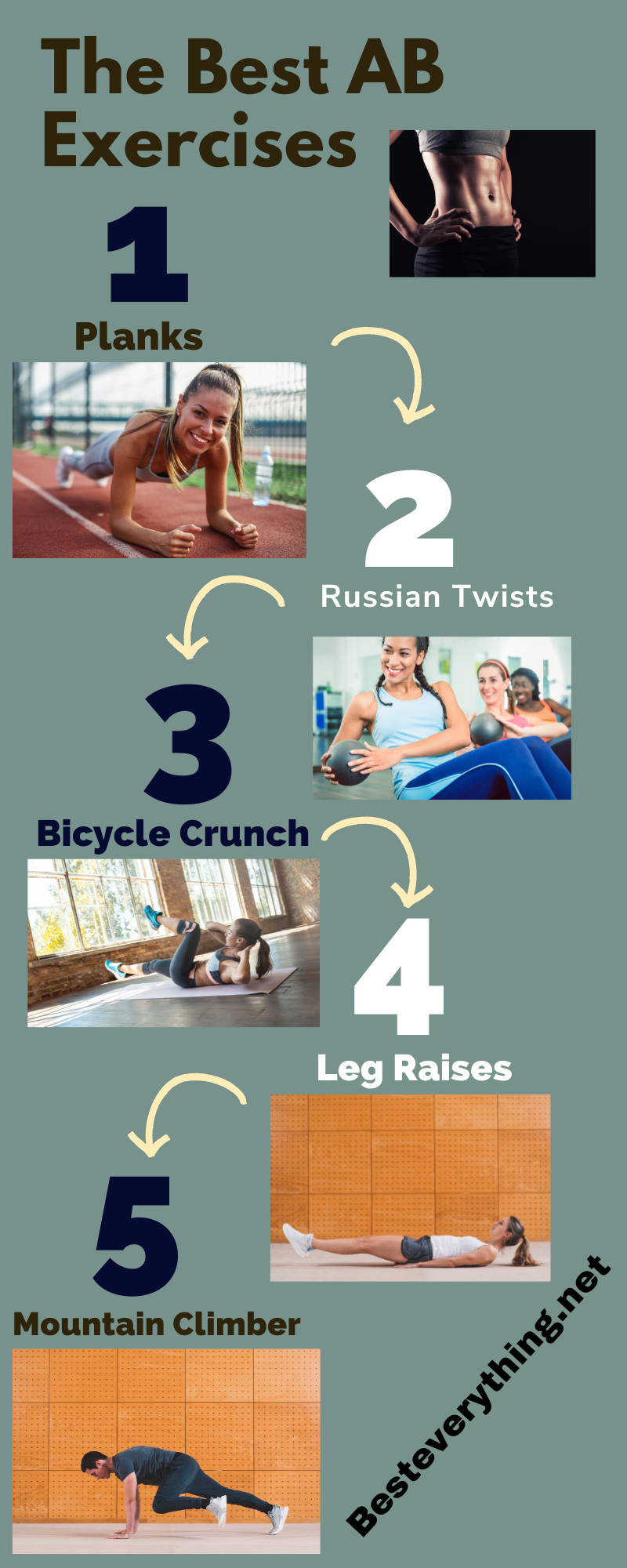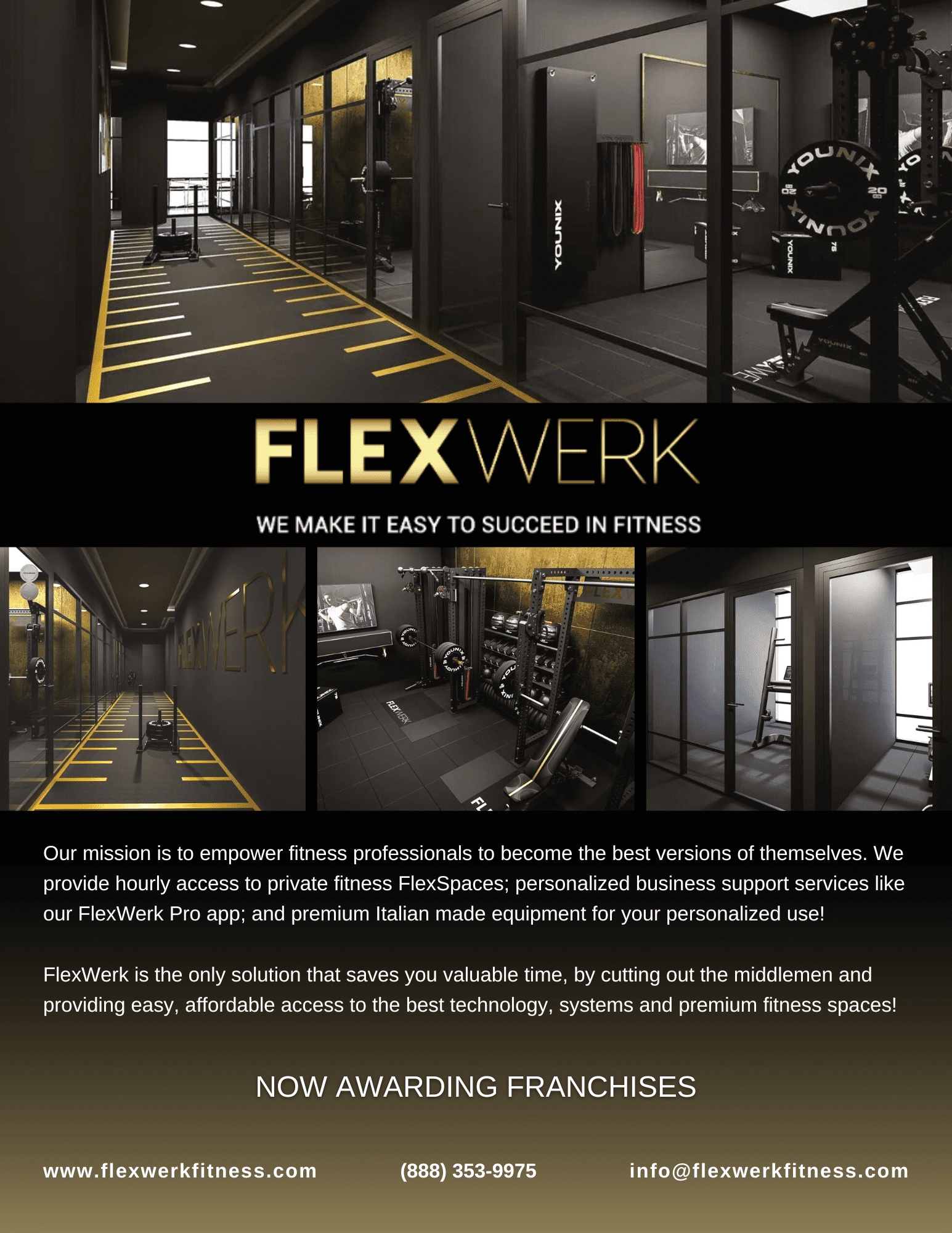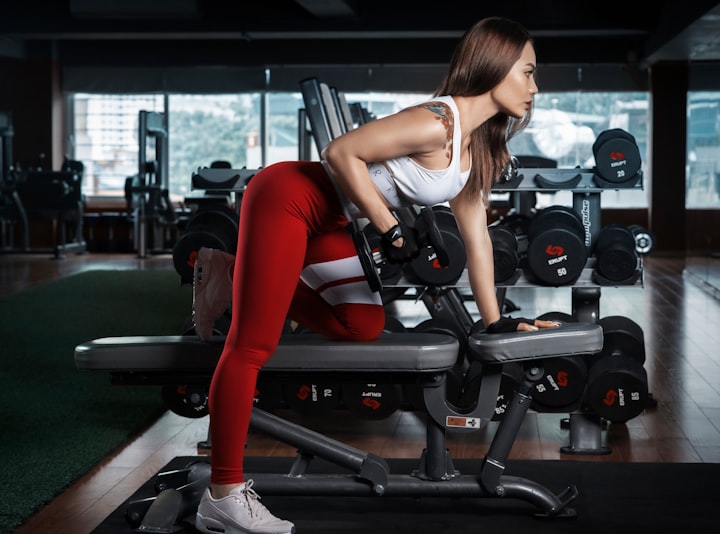The Best AB Exercises


AB Exercise Benefits
Abdominal exercises provide a wide range of benefits for people of all ages and fitness levels. These exercises not only strengthen your core muscles, but also help you build a strong and healthy body. Not only do ab exercises improve overall strength and stability, but they can also help with weight loss and reduce the risk of chronic diseases.
The best ab exercise to perform is one that works all the major muscle groups in the abdominal area. This can include planks, crunches, sit-ups, leg raises and more. When doing these exercises correctly, you’ll target both your upper and lower abs while increasing strength and stability in your core muscles. Additionally, performing regular abdominal exercises will help with maintaining good posture which can lead to improved mobility during everyday activities like running or lifting weights.
Exercise 1: Plank
Plank is a great exercise for strengthening your core muscles and sculpting your midsection. This simple move requires no equipment, and can be easily adapted to increase the difficulty as you become stronger. The plank is an essential part of any ab-strengthening workout routine, and it's one of the best exercises for targeting the abs from all angles.
When performing the plank, ensuring correct form is key in order to maximize results and avoid injury. Start by lying face down on a mat with your elbows beneath your shoulders and hands flat on the ground next to them. Lift up onto your toes, keeping your body in a straight line from head to toe. Engage your abs by drawing them inward towards your spine, avoiding arching or sagging at either end of the body.
Exercise 2: Russian Twist
Exercise 2: Russian Twist is a dynamic core exercise that helps to target your abdominal muscles and obliques. This exercise will help you build stability, balance, and strength in the abdominal area. It is easy to perform, but requires great focus for maximum efficiency.
To do this exercise properly, start by sitting on the floor with your knees bent and feet flat on the ground. Engage your abs as you lean back slightly so that your torso makes a 45-degree angle from the floor. Bring both hands close together above your chest. Then twist from side to side while keeping your arms straight out in front of you and engaging your core throughout the movement. Do 12 repetitions on each side for one set before resting for 30 seconds before performing another set of 12 reps on each side or any other variation you prefer.
Exercise 3: Bicycle Crunch
Exercise 3: Bicycle Crunch is one of the most effective abdominal exercises to get a strong and toned core. It's an advanced ab exercise that helps to target your entire midsection, including your obliques and hip flexors. Bike crunches are easy to learn, making them great for beginners too.
To do a bicycle crunch properly, start by lying flat on the floor with your hands behind your head and elbows out wide. Bring one knee up towards you chest as you twist your upper body so that the opposite elbow meets it. Your opposite leg should be straight and hovering off the ground. Return back to starting position then repeat with other leg. Keep alternating legs for each rep for 15-20 repetitions or 3 sets of 8-10 reps depending on intensity level desired.
Exercise 4: Leg Raise
Exercise 4: Leg Raise is an effective exercise for toning your abdominal muscles. It targets the lower ab muscles in particular and can be done at home or in the gym. Begin by lying on your back on a flat surface with both arms extended out to the sides. After that, slowly raise your legs slightly above hip level until you feel tension in the abdominals, then return them to their starting position. You can make this exercise more challenging by holding dumbbells or medicine balls between your feet as you perform each leg raise. This will require extra effort from your core and help you work those abs even harder! Incorporating this exercise into your routine a few times a week should get you noticed results within no time.
Exercise 5: Mountain Climber
The mountain climber is an effective and efficient abdominal exercise that provides a comprehensive ab workout. It strengthens the core muscles while improving balance and coordination. The mountain climber targets both the upper and lower abdominal muscles, as well as helps to build strength in the hips, glutes, shoulders, arms and back.
To perform this exercise correctly, start in a plank position with your hands directly beneath your shoulders. Your feet should be slightly apart with toes tucked underneath. Next, lift one knee towards your chest alternating between legs for 30 seconds at a time for multiple sets of repetitions. Make sure to keep your back straight and core engaged during each repetition to ensure proper form throughout the entire exercise.
Tips for Effective AB Workouts
For any fitness enthusiast, getting the best abs requires both dedication and hard work. It is important to combine effective ab exercises with a healthy diet and regular cardio workouts for maximum results. To help you get started on your journey to achieving your perfect abs, here are some tips for effective AB workouts.
First and foremost, it is essential to give your body enough rest between intense abdominal workouts. This will ensure that you don’t overwork or strain any of the muscles in your core and that you can perform each exercise with maximum effectiveness. Additionally, it is important to include a variety of different exercises in your ab routine—such as planks, crunches, leg lifts, and flutter kicks—to target all areas of the abdominal region effectively.
Core strength is an essential part of overall physical fitness and health. Regular ab exercises can help you strengthen your core, improve posture and balance, prevent back pain, and even provide added protection during sports activities. There are many different types of ab exercises available to choose from; some focus on one specific area while others work multiple muscles at once. Ultimately, the best ab exercise for you depends upon your current level of fitness and goals.
No matter which type of abdominal exercise you choose to do, it's important to maintain correct form throughout each movement in order to get the most out of the exercise and reduce the risk of injury. Additionally, it's wise to incorporate other forms of cardiovascular activity into your routine such as running or cycling in order to help burn fat and increase muscle tone all over your body.
Why are AB Exercises Important?
AB exercises are important for maintaining core strength. Core strength is a vital component of overall fitness, and helps support proper posture as well as providing stability during certain movements. A strong core helps to protect essential organs and can even reduce the risk of injury by improving balance and coordination. AB exercises target the muscles in the abdomen, which help to make up an individual’s core. Strengthening these muscles can make everyday activities such as reaching overhead or lifting objects easier and less likely to cause injury. AB exercises also help with athletic performance; having a strong core can improve speed, agility, power output and muscular endurance in sports activities. Additionally, it is crucial for supporting spine health since the abdominal muscles work closely with the back muscles to hold our bodies upright and provide adequate stability for any activity we are undertaking.
Why is it Important to Not Yank on Your Neck When Doing Sit-Ups?
It's important to avoid yanking on your neck when doing sit-ups because it can cause lasting damage to the spine as well as lead to severe pain and discomfort. Not only is it detrimental for your long term health, but it can also hinder your progress in developing core strength. When performing sit-ups, you should always be mindful of proper technique in order to ensure maximum efficiency and safety.
Why is Technique so Important When working your ABs?
Having strong abdominal muscles is essential for maintaining a healthy body and core strength. This makes it important to understand the correct technique when working your abs in order to ensure they are strengthening properly. Proper form helps you work your muscles more effectively and can also help prevent injury.
Using proper technique allows you to maximize the benefits of each exercise by targeting specific muscle groups, thereby increasing the effectiveness of your ab exercises. The correct form not only helps you get the most out of each exercise but also ensures that those abs are being worked safely and efficiently. If done improperly, an exercise may do more harm than good; for example, if done incorrectly sit-ups could actually put strain on your lower back instead of helping to strengthen it.
What is the Number 1 AB Exercise?
The number one best ab exercise is undoubtedly the plank. The plank is a full-body exercise that works to build strong abdominals, back and shoulder muscles. It’s high-impact, meaning it burns lots of calories in a short period of time and can help you lose weight quickly. It helps build core strength by engaging all the abdominal muscles, improving posture and balance, as well as aiding in spinal stability. Planks also require no gym equipment or weights so they can be done almost anywhere.
To do a plank correctly, start on your hands and knees with your hands directly below your shoulders and your feet hip-distance apart on the floor. Then shift forward onto your toes while keeping a straight line from head to toe with your abdominals pulled in tight towards your spine.
Does Having Weak ABs put Strain on Your Back?
Having weak abdominal muscles can put a strain on your back, leading to chronic pain and discomfort. As the body's natural core stabilizers, weak abs can lead to an increased risk of injury when engaging in physical activities like running or sports. Without strong abdominal muscles helping to bear the load, your spine is left vulnerable as it compensates for the lack of support by bearing more weight than it should. This puts pressure on your lower back and can lead to soreness, muscle fatigue, and tension in the area.
The repercussions of having weak abs extend beyond simply stressing out your back: poor posture brought on by weak abs can exacerbate any existing issues you may have with your vertebrae as well as cause headaches due to tension. Additionally, weakened abdominal muscles compromise balance and coordination which increases risk of falls or slips that could result in further injury.
How do I do AB Exercises if I Can't Stand?
Living with an injury or disability that affects your mobility can make exercise difficult. However, just because you cannot stand does not mean you have to miss out on ab exercises. With a few simple modifications, it is possible for anyone to work their core muscles, no matter what their mobility limitations may be.
The first thing to do is find the right surface and equipment. Start with a comfortable and supportive surface like the floor or a bed. If necessary, use a pillow or cushioning materials to ensure you are in the correct position without discomfort. You will also need something like an exercise ball or therapy band that can provide extra resistance while exercising while seated.
How Long Will it Take to Get a Six-Pack?
Achieving a six-pack abs is the dream of many fitness enthusiasts. There is no definite answer to the question, ‘How long will it take to get a six-pack?’ as it depends on several factors such as genetics, overall health, diet and exercise habits. Generally speaking, if one follows an appropriate workout routine along with healthy eating habits then they can expect to see visible results within two or three months.
However in terms of achieving a complete and defined set of abs that are visible from any angle might take about 6-8 months for most people. This timeline may vary depending on the individual's body fat percentage and muscle mass at the start of their journey.
Is it Possible to Get a Six-Pack Without Changing my Diet?
The question of whether or not it is possible to get a six-pack without changing one's diet has been asked for years. Although this may have been an unattainable goal in the past, advances in exercise science and nutrition have made it possible to achieve this feat with proper hard work and dedication. It is undeniable that making dietary changes will help anyone reach their fitness goals quicker and more effectively. However, there are certain strategies one can use to build up abdominal muscles even without modifying their diet significantly.
For starters, having a regular workout routine that focuses on core exercises like planks, crunches, Russian twists and leg raises is essential in developing those coveted “six-pack” abs.
What is the Most Important Muscle Group to Exercise?
For overall health and well-being, one of the most important muscle groups to exercise is the core. The core muscles are located in your abdomen, hips, and back. They provide stability for everyday movements and protect your spine by helping you maintain proper posture. Regular core exercises can help you perform activities with better form, balance, and coordination—making daily tasks easier to complete. Additionally, strengthening your core muscles can help reduce back pain and improve overall fitness levels.
The core muscle group includes multiple muscles that should all be targeted during a workout routine. These include abdominal muscles such as the rectus abdominis (the “six-pack”), internal obliques on both sides of the body, external obliques just above them, lower back extensors which run up to the neck area from either side of the lower spine.
How Often Should the ABs be Worked?
Having an effective abdominal routine is essential for a strong, healthy core. Deciding how often to work your abs is important for the development of the muscles in that region. It is not necessary to do ab exercises every day, but when done frequently and consistently with correct form, core strength will be improved significantly.
Ideally, it's best to do abdominal exercises 2-3 days a week. During each workout session, aim to include at least two different ab exercises targeting different muscle groups such as crunches and planks or Russian twists and leg lifts. This way, you'll get a more balanced workout and reduce the risk of overuse injuries by avoiding repetitive movements on the same muscles all the time.
Does a Beer Belly Damage Your ABs?
As a fitness enthusiast, the question of whether or not having a beer belly damages your abdominal muscles has long been on my mind. I've seen firsthand how dedicated gym goers are to their daily ab workouts, and yet they still struggle with maintaining the flat stomach they desire. On the other hand, those who indulge in too much alcohol have the opposite problem - their bellies protrude outwards with little hope for improvement. So does having a beer belly actually damage your abs?
The answer is yes - there's no denying it. Just like any other muscle group in our bodies, if you don't use them then they will begin to deteriorate and weaken over time. This means that if you're consistently drinking large amounts of alcohol and not engaging in any ab training or physical activity then your abdominal muscles will become weaker and less toned than before.
How do I Motivate Myself to Workout? Especially ABs!?
For me, one of the most satisfying parts of going to the gym is the feeling I get after a good workout. On especially tough days, my ab muscles burn so much that it almost feels like they’re on fire. While it can be painful in the moment, I know it means that I am challenging my body and progressing toward my goals. I find strength in knowing that this sensation is temporary but worth pushing through for long-term benefits.
My ab burning has become a source of motivation for me to push past what would have previously been impossible. It means that while I may be sore and tired now, it will improve with continued activity and effort from me. It also encourages me to try new exercises or increase intensity when doing old ones; even though there may be pain associated with these activities initially, the results are worth it in the end.
The Best of Everything. We Research Everything so You can Make an Informed Decision.



Comments ()